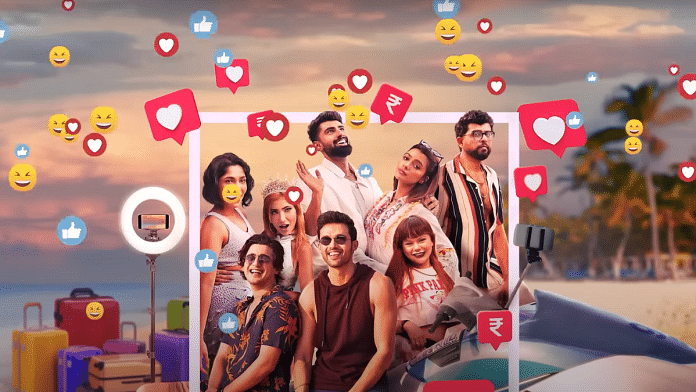Netflix’s Social Currency is a pastiche of reality shows like Roadies, Splitsvilla, and Bigg Boss with bits of Fear Factor thrown in. But what sets it apart from the rest is that for the first time in the history of Indian reality TV, the participants are social media influencers — and they have 21 days to show who has the most social capital.
The OTT platform’s nod to this ilk of celebrities is an acknowledgement that creators’ influence can no longer be ignored. Even Prime Minister Narendra Modi and Congress leader Rahul Gandhi carve out time from their hectic schedules to interact with influencers like Siddhaarth Aalambayan and Shraddha Jain aka ‘Aiyyo Shraddha’.
The highbrow Cannes Film Festival 2023 rolled out the red carpet for at least 10 Indian influencers, from Dolly Singh to Masoom Minawala. It was an unprecedented move that was both welcomed and dismissed in equal measure. And in 2022, Koffee With Karan had featured comedians Tanmay Bhatt and Danish Sait and creators Kusha Kapila and Niharika NM, who graced the most coveted couch in India’s entertainment industry.
Love them or hate them, you cannot wish influencers away. And Netflix is banking on this push-and-pull dynamic to boost Social Currency’s viewership. The message is loud and clear: Influencing is bigger than ever before, and social currency is the new money.
Influencers work behind filters and cameras on Facebook, Instagram, Snapchat, YouTube, Twitter, and so on. These experiences of getting ‘influenced’ are highly curated in themselves. The format of Social Currency forces its participants to engage with people in real life and see if they can bank on their real world social currency to win.
Also read: Never Have I Ever finally breaks Indian-American trope. Girls chasing boys, not just Princeton
A spectrum of influencers
Convincing people to buy something in-person is way tougher than advertising it through a video. The winner will leave with a Rs 50 lakh cash prize and enough content to satiate followers for some time.
Shot in Goa, Social Currency features a range of influencers — from comedian Aakash Mehta, who is followed by more than 91,000 users on Instagram, to Ramanand Sagar’s granddaughter and singer-songwriter Sakshi Chopra with a massive Instagram following of more than five lakh. TV actor Parth Samthaan, with four million followers, and Delhi-based fashion influencer Mridul Madhok, with two million followers, are featured too, among others.
Social Currency ranks all participants — eight in number — based on their Instagram follower counts. While some are full-time creators, others had taken up influencing as a ‘side hustle’ — which is now perhaps even more rewarding than their main profession. Mehta is not a typical influencer but more of a stand-up comic, while Vagmita Singh is a screenwriter who also does comic sketches. Samthaan shot to popularity as a TV actor with his roles in popular shows such as Yeh Hai Ashiqui (2013-16), Kaisi Yeh Yaariyan (2014), and Kasauti Zindagii Kay (2018-20), the reboot of the OG Ekta Kapoor blockbuster Kasauti Zindagi Ki from 2001.
Even mainstream Bollywood actors are turning to influencing—Jacqueline Fernandes and Parineeti Chopra are new entrants.
Social Currency is trying out a format similar as the one in Black Mirror 3’s first episode called Nosedive, which looks at a future where people rate their interactions with others on a scale from one to five stars. This rating system cumulatively affects everyone’s socioeconomic status or social capital/currency. The format of Social Currency, though, is tamer, and more sanitised.
From roasting each other to performing various tasks on the streets like belly dancing and selling sand to tourists to helping Covid-affected businesses sell their wares, influencers are forced to bring in their A-game in content creation.
Influencers, who grab audience attention on their social media accounts with PR packages, sponsored trips, and food coupons, are given a tight budget in Social Currency and forgo their massive following and create a new Instagram handle in the show.
Portal to multiverse of stardom
The Kardashians, Prince Narula, and Rannvijay Singha of Roadies fame were perhaps the first reality TV ‘influencers’ to make their mark. Netflix platformed more personalities over the years — from Too Hot to Handle’s Francesca Farago and her whopping 6 million Instagram followers to Indian Matchmaking’s Sima Taparia.
But the streaming giant has now learnt that the business of creating influencers isn’t enough, capitalising on their fame is the next step. The appetite for influencer-related content is at an all-time high.
From Ranveer Allahbadia, who not only walked the red carpet at Cannes but now also interviews India’s top ministers, to Dolly Singh sashaying her way into OTT projects like Lionsgate Play’s Feels Like Home, the portal to the multiverse of stardom is opening up, and influencers are getting into it.
Contrary to popular opinion, Bollywood is no longer the goal; it is actually OTT platforms. Kusha Kapila is the top influencer in terms of her social capital. From being a ‘celebrity guest’ in Social Currency to judging comic talents on Amazon miniTV’s Case Toh Banta Hai and acting in Masaba Masaba (2022), Kapila is redefining stardom in the influencer industry.
Social Currency is more of a reality check than a reality show, more for naysayers than influencers. But it does not go beyond saying that influencers can now have their own reality show. Even the format comes across as haphazard at times — makers seem unsure about how to package the content right. The ‘hard’ questions are treated with kid gloves, and issues like mental health, body shaming, and sexual harassment are gimmicky causes instead of conversation starters. It is a missed opportunity to show how far OTT’s marriage with content creation can go.
(Edited by Humra Laeeq)



